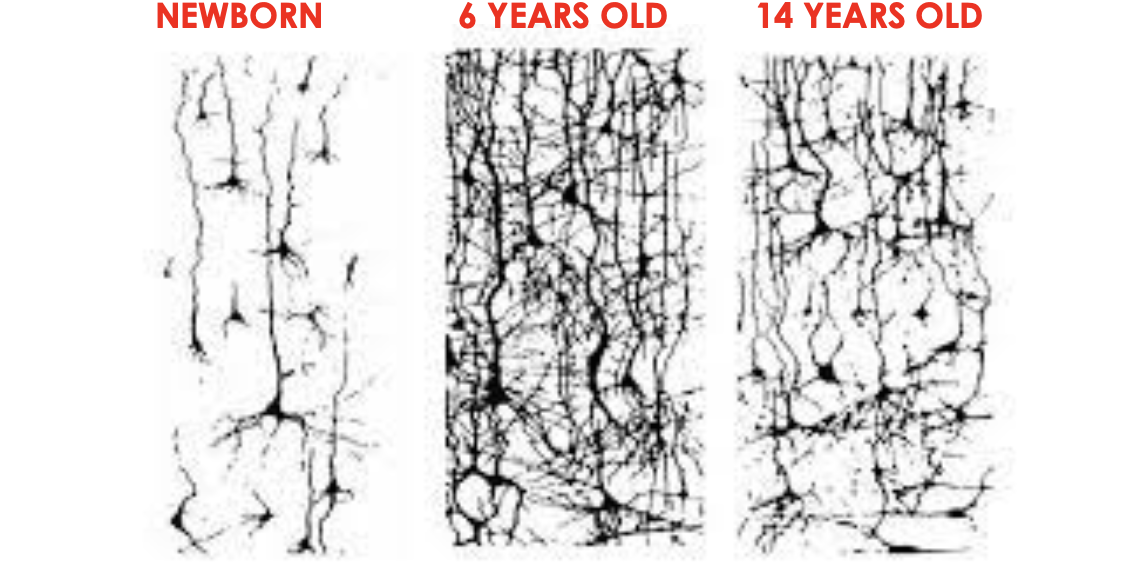Cognitive development in adolescence
1/31
Earn XP
Description and Tags
Cognitive development in adolescence brain changes
Name | Mastery | Learn | Test | Matching | Spaced |
|---|
No study sessions yet.
32 Terms
Brain changes in adolescence
Adolescence is a period of significant brain changes.
Previous theories suggested that the adolescent brain was already fully formed.
We now know that the brain continues to develop even into the early stages of adulthood (25/30 years old)
Which two main changes in our brain do we have?
Structural changes
Functional changes
Synaptic pruning
Universal process.
The basis of human learning.
Synaptic connections are eliminated.
Neurons that are frequently used develop stronger connections, but those that are not used or are used very little will be eliminated.
Neural remodeling is essential for brain maturation.
Synaptic pruning

Structure and composition of the cerebral cortex
In the frontal lobes (related to executive functions): the increase in white matter continues (earlier in women than in men).
There is a reduction in gray matter through the pruning of dendritic connections that were not used during childhood → this increases the brain's efficiency (fewer neural connections but stronger, more homogeneous, and effective).
It starts in the posterior areas of the brain and moves forward to the more anterior areas, reaching the prefrontal cortex by the end of adolescence.
Physical development of the brain
related to Cortical and Subcortical Systems
amygdala and frontal lobes
Cortical and Subcortical Systems
Amygdala:
• It participates in emotional and instinctive reactions > more active in early adolescence.
• Frontal lobes:
• They are associated with problem-solving, reasoning, goal setting, planning, emotional regulation, and impulse control (executive functions) > more active in late adolescence.
This can explain the tendency to seek out emotions and novelty, as well as the difficulty in focusing on long-term goals.
characteristic risk-seeking behaviour
result from the interaction of two brain networks::
• Socioemotional network
• Cognitive control network
Socioemotional network
Sensitive to social and emotional stimuli (e.g., peer
influence) > its activity increases during puberty
Cognitive control network
Regulates responses to stimuli > matures more gradually
and over a longer period of time.
factors related to slow and extensive brain development
highly susceptible to environmental influences (easily affected), both positive and negative (e.g., drugs).
The importance of cognitive stimulation during adolescence > bidirectional impact.
Activities and experiences determine which connections are
preserved and strengthened.
Strengthened connections in certain brain areas enable greater cognitive control over functions.
Myelination
Process of forming myelin sheaths around nerve fibers.
It improves the conduction of nerve impulses and promotes the connection between neurons.
Greater brain efficiency.
Structural changes
ARE THE BASIS FOR THE DEVELOPMENT OF HIGHER COGNITIVE SKILLS SUCH AS ABSTRACT THINKING, WHICH IS HIGHLY INVOLVED IN IMPROVING PROBLEM-SOLVING AND DECISION-MAKING.
abstract thinking
grants the ability to:
• Define & discuss abstractions such as love, justice, freedom.
• Use terms like: however, anyway, therefore, probably, to express logical relationships.
Language development
Refinement > adult reading material = vocabulary growth (crucial for reading comprehension).
Becoming aware of words as symbols that can have multiple meanings.
Enjoying the use of irony, wordplay, and metaphors.
language leads to
Greater skill in social perspective > ability to adjust one's way of speaking to the other person's level of knowledge and point of view.
Essential ability to converse or persuade.
Pubilect
Social dialect of puberty.
Teen slang filled with exclusive terms as part of developing an independent identity separate from parents and the adult world.
It helps strengthen group identity and exclude adults.
It is characterized by rapid changes: new terms are constantly invented.
Vocabulary varies based on gender, ethnic background, age, geographic region, neighborhood, type of school, and from one group to another.
Generation cap
Informal nature of pubilect
Dynamic nature of pubilect
Informal nature of pubilect
If we ask a Gen Z teenager how a certain word is used, he could have doubts because there are no explicit or clear rules for these terms.
Instead, it is a "use-as-you-go" or an unstructured use of language.
teen language casual and not used in formal situations
Dynamic nature of pubilect
A millennial uses different terms that were part of the pubilect of his/her generation.
teen language constantly changes — it's always evolving with trends, media, and culture.
Language and realities
LANGUAGE CREATES REALITIES
REALITIES CREATE LANGUAGE
Changes in working memory
A process that begins in middle childhood.
An opportunity to handle complex problems or decisions involving multiple pieces of information.
Metamemory
Self-control and self-monitoring that people have over their own memory processes
Metacognition
Self-control and self-monitoring that individuals have over their own thought processes
where is the growing amount of knowledge stored
LTM (Long-Term Memory).
Which three types of stored knowledge do we have?
Declarative knowledge
Procedural knowledge
Conceptual knowledge
Declarative knowledge
knowing what
factual knowledge (data, facts, concepts, principles).
Procedural knowledge
knowing how...' > skills.
Conceptual knowledge
'knowing why...' >
abstract understanding.
Improvements in information processing
Processes for acquiring, managing, & retaining information > learning, memory, reasoning.
Increase in processing speed.
Greater development of executive function > selective attention, decision-making, inhibitory control of impulsive responses, and working memory control.
Executive function
selective attention, decision-making, inhibitory control of impulsive responses, and working memory control.